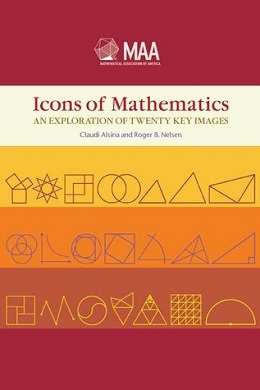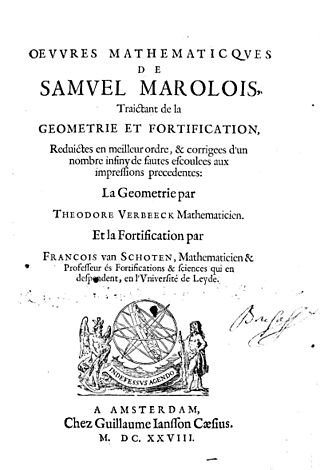
Ronald Lewis Graham was an American mathematician credited by the American Mathematical Society as "one of the principal architects of the rapid development worldwide of discrete mathematics in recent years". He was president of both the American Mathematical Society and the Mathematical Association of America, and his honors included the Leroy P. Steele Prize for lifetime achievement and election to the National Academy of Sciences.

Girard Desargues was a French mathematician and engineer, who is considered one of the founders of projective geometry. Desargues' theorem, the Desargues graph, and the crater Desargues on the Moon are named in his honour.

In projective geometry, Desargues's theorem, named after Girard Desargues, states:
In geometry and in its applications to drawing, a perspectivity is the formation of an image in a picture plane of a scene viewed from a fixed point.

De prospectiva pingendi is the earliest and only pre-1500 Renaissance treatise solely devoted to the subject of perspective. It was written by the Italian master Piero della Francesca in the mid-1470s to 1480s, and possibly by about 1474. Despite its Latin title, the opus is written in Italian.

Kirsti Andersen, published under the name Kirsti Pedersen, is a Danish historian of mathematics. She is an Associate Professor of the History of Science at Aarhus University, where she had her Candidate examination in 1967.
Hazel Perfect was a British mathematician specialising in combinatorics.

Viewpoints: Mathematical Perspective and Fractal Geometry in Art is a textbook on mathematics and art. It was written by mathematicians Marc Frantz and Annalisa Crannell, and published in 2011 by the Princeton University Press (ISBN 9780691125923). The Basic Library List Committee of the Mathematical Association of America has recommended it for inclusion in undergraduate mathematics libraries.
Linda Dalrymple Henderson is a historian of art whose research involves the connections between modern art, science and technology, and the occult. She is the David Bruton, Jr. Centennial Professor in Art History at the University of Texas at Austin.
Algorithmic Geometry is a textbook on computational geometry. It was originally written in the French language by Jean-Daniel Boissonnat and Mariette Yvinec, and published as Géometrie algorithmique by Edusciences in 1995. It was translated into English by Hervé Brönnimann, with improvements to some proofs and additional exercises, and published by the Cambridge University Press in 1998.

Computability in Analysis and Physics is a monograph on computable analysis by Marian Pour-El and J. Ian Richards. It was published by Springer-Verlag in their Perspectives in Mathematical Logic series in 1989, and reprinted by the Association for Symbolic Logic and Cambridge University Press in their Perspectives in Logic series in 2016.
Mathematical Excursions: Side Trips along Paths Not Generally Traveled in Elementary Courses in Mathematics is a book on popular mathematics. It was written by Helen Abbot Merrill, published in 1933 by the Norwood Press, and reprinted (posthumously) by Dover Publications in 1957.

Icons of Mathematics: An Exploration of Twenty Key Images is a book on elementary geometry for a popular audience. It was written by Roger B. Nelsen and Claudi Alsina, and published by the Mathematical Association of America in 2011 as volume 45 of their Dolciani Mathematical Expositions book series.
A Topological Picturebook is a book on mathematical visualization in low-dimensional topology by George K. Francis. It was originally published by Springer in 1987, and reprinted in paperback in 2007. The Basic Library List Committee of the Mathematical Association of America has recommended its inclusion in undergraduate mathematics libraries.
Rona Gurkewitz is an American mathematician and computer scientist, known for her work on modular origami. She is a professor emerita of computer science at Western Connecticut State University, and the former head of the department of computer science there.
Judith Veronica Field is a British historian of science with interests in mathematics and the impact of science in art, an honorary visiting research fellow in the Department of History of Art of Birkbeck, University of London, former president of the British Society for the History of Mathematics, and president of the Leonardo da Vinci Society.
Joan Livingston Richards is an American historian of mathematics and a professor of history at Brown University, where she directs the Program of Science and Technology Studies.
Snezana Lawrence is a Yugoslav and British historian of mathematics and a senior lecturer in mathematics and design engineering at Middlesex University.
Combinatorics: The Rota Way is a mathematics textbook on algebraic combinatorics, based on the lectures and lecture notes of Gian-Carlo Rota in his courses at the Massachusetts Institute of Technology. It was put into book form by Joseph P. S. Kung and Catherine Yan, two of Rota's students, and published in 2009 by the Cambridge University Press in their Cambridge Mathematical Library book series, listing Kung, Rota, and Yan as its authors. The Basic Library List Committee of the Mathematical Association of America has suggested its inclusion in undergraduate mathematics libraries.

Samuel Marolois was a Dutch mathematician and military engineer who is best known for his work on perspective.








